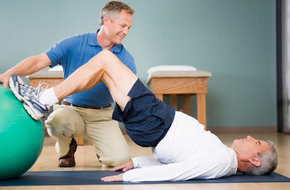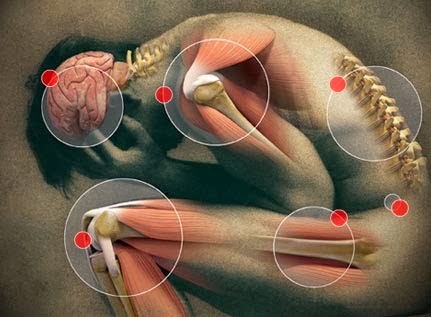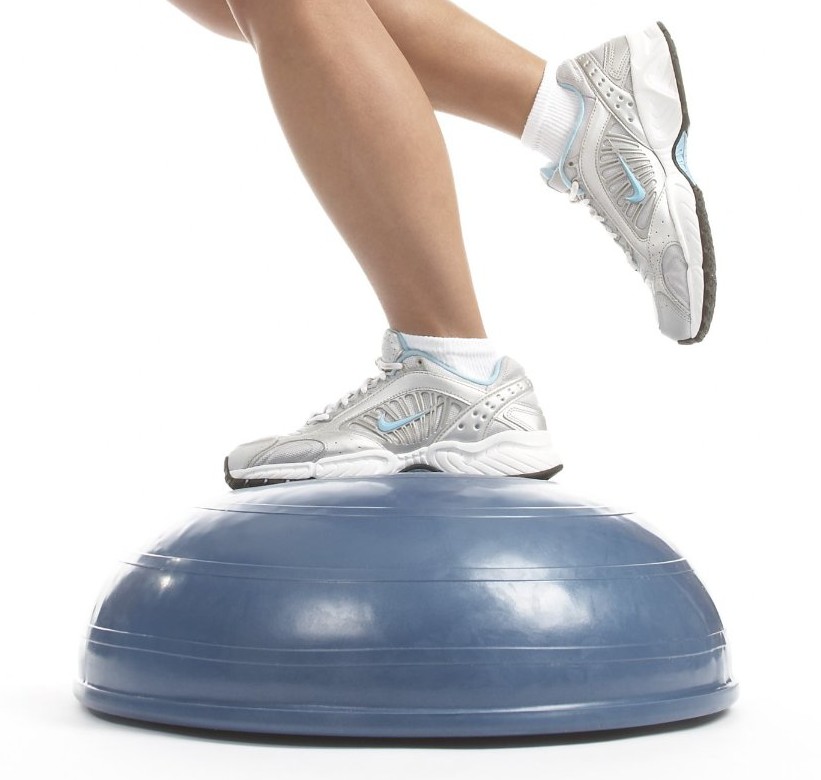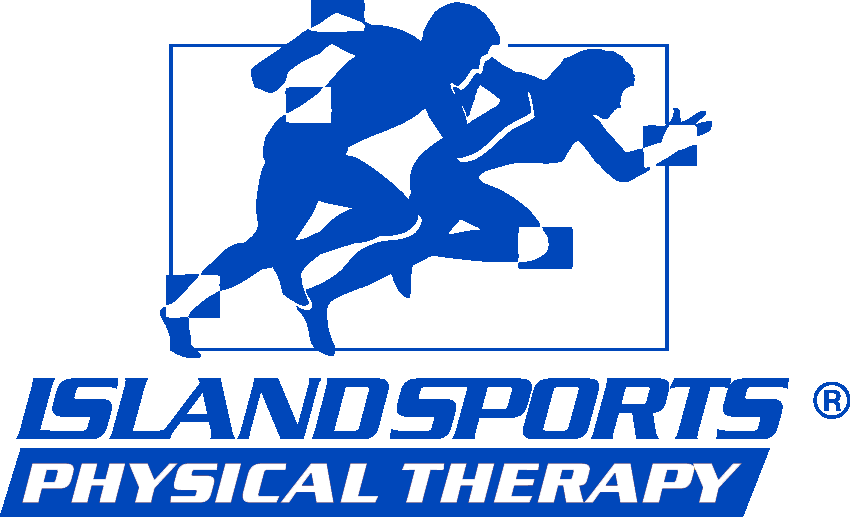
Physical Therapy in East Northport
Gait training, or gait rehabilitation, is a form of physical therapy which helps people of all ages improve their ability to stand or walk after sustaining an injury or disability. Island Sports Physical Therapy, with locations in East Northport, Huntington, Nesconset, Coram, East Meadow, and Glen Cove, focuses on the individual first as they try to achieve their rehabilitative goals.
Fall prevention is one of the main reasons for gait training, especially for the elderly. Falls are the leading cause of fatal and non-fatal injuries in the elderly, and one-third of all Americans aged 65 and older fall each year. Gait training can be used as a preventative measure for older people who wish to remain independent or who live alone. Island Sports Physical Therapy can make sure you learn the correct movements and techniques to avoid falls.
Gait training is also used as a rehabilitative measure for people who may have lost the ability to walk due to an injury or illness. Gait training will begin once prescribed by a doctor as a part of a physical therapy routine. The patient will first be evaluated by the physical therapist to see if they are physically able to perform the movements of gait training. The physical therapists at Island Sports Physical Therapy will be able to give a patient an individualized plan of action to execute both in the home and at the office.
A person who has been immobile for quite some time may have difficulties walking again, and since gait training is exercising the cardiovascular system, the transition may be a little tough for those with walking issues. The physical therapists at Island Sports Physical Therapy realize that this can be both a physical and mental challenge, and are there to help you every step of the way towards your goal of improved or regained mobility.
Physical Therapy for Neurological Rehabilitation
Nervous system damage can be caused by various conditions or disorders such as stroke, Parkinson’s, cerebral palsy, and multiple sclerosis. Physical therapy for treatment or recovery, also known as neurorehabilitation, aims to help patients successfully overcome these ailments. The process can be long and quite arduous as some patients must either learn a “new way” to live, or slowly recover functionality that may have been lost due to the condition or disease. If there has been brain or spinal damage, neurorehabilitation aims to have the patient gain independence and help families cope with the change and adapt to this new way of living that physical therapy hopes to develop.
Neurorehabilitation uses the skills and abilities that have not been compromised by the condition or disease in order to find the highest order of independence possible. Damage to the nervous system can take away the most basic of functions for a patient, and getting them back to living a normal life the best way they can is the ultimate goal. Physical therapy can help patients find a way to live with the condition, find happiness, and regain lost self-esteem due to the condition or the disease.
The nervous system is repaired through increasing the patient’s well being while training or re-teaching patients various mobility, communications, or occupational therapies while aiming to restore the person back to a normal, daily routine. Neurorehabilitation uses a wide variety of different methods to do this, including holistic approaches, while focusing on nutrition and creativity in order to get the patient back on his or her feet. Speech therapy is also a big part of neurorehabilitation as these conditions or diseases may cause a patient to lose cognitive and speaking abilities, and with the advancement of science and technology, these therapies are helping people more and more with their recovery.
How to Do a Proper Warmup/Cooldown When Exercising
Exercising is a great physical activity, but it is just as important to warm up before and cool down after you perform your exercise as it could even help prevent you from injury. Warmups and cooldowns are also said to improve athletic performance, although there is no actual evidence. There is some controversy to these exercises, but they also don’t pose any risks to the user as well. Some people don’t prefer to do them because it takes time the hat some don’t have, but all it takes is a few extra minutes that could help you out in the long run.
Warmups usually involve performing the activity you are about to do at a slower pace and with reduced intensity. Warming up before the main exercise gets the body’s cardiovascular system working, and it also dilates the blood vessels ensuring that the muscles are well supplied with oxygen, and ready to perform physical activity. When preparing to do a warmup, you should focus on the larger muscles first, like hamstrings or quads, and go from there to the specific muscles you will use in your activity. It’s normal to start sweating a little while warming up, but you won’t feel fatigued and exhausted, that will most likely come after the main exercise.
Cooldowns are just like warm-ups, but you are in gradual recovery and the key is to lower your heart rate and blood pressure. The cooldown should last just as long as a warmup (5-10 minutes) to get you ready for the exercise as going at a slower pace will help bring your heart rate down gradually and you won’t feel like you will want to pass out right after exercise.
It is common to think that stretching and warmups/cooldowns are the same thing, but they actually are two separate things. Stretching should come after warmups/cooldowns when your muscles are still warm. Stretching can improve your range of motion against a joint and improve flexibility as well, thus improving performance too. Stretching also reduces the buildup of lactic acid which can lead to muscle cramps and stiffness.
Warm-ups and cooldowns when exercising will help loosen you up, as well as possibly preventing injury and help with your performance. It doesn’t take that much extra time to perform, plus you’re helping yourself out by helping your body. Try walking to and from the gym if it is close enough, that’s an easy way to warm up and cool off after hitting the gym. Stretching is helpful as well, but combining the three could really help you out, and make you feel better after a good workout!

Total Joint Replacement and How Physical Therapy Can Help
As you get older, you might need a total joint replacement in your hip or your knee, which will require surgery and physical therapy to help get you back on your feet and moving freely and independently. Physical therapy is an essential medicine that will get your muscles and joints moving and strengthen them as well. If you need this kind of surgery, you may be apprehensive at first, but a good physical therapist you will help you get back on your feet in your normal routine within several months. The process is not overnight, though, and is why sticking to your exercises and listening to your physical therapist is important in your recovery.
You will most likely start physical therapy shortly before the surgery so they can help familiarize you with the exercises you will be doing post surgery and to make sure you know how to perform them properly so you can train on your own as well. A physical therapist will help the patient learn to walk with crutches for after the surgery, will teach them how to adapt at home, and will warn them about possible precautions and movements to avoid. These preparations are common for total joint replacements, such as a total knee replacement (TKR). If you are in good physical shape prior to the surgery, it is better for you as you adjust to physical therapy and the various exercises to help you regain movement and strength.
Your physical therapist will help you practice walking in short distances after surgery, and continuing practice with a cane or crutches. After a surgery such as a total knee replacement, patients will usually go home after two or three days. Patients have to learn safe movements getting into and out of bed, and sitting down and getting up. Physical therapy will continue to train patients with exercises focused on flexibility. Your activity level should be increased after the surgery and moving on to exercises such as stairs with help push your body. One of the main goals by discharge is to have 90 degrees range of motion in the joint that you had the surgery, and will be taking less pain medicine once you leave the hospital.
If you remain on the schedule your physical therapist has given you, and you are practicing out exercise regularly, you will see a dramatic improvement in several weeks after physical therapy, and hopefully, you will be able to walk again on your own if you had a total knee replacement. Further exercises as you progress would be using a stationary bike to stretch your muscles and have further movement, partial joint bending, practice sitting up and standing, and step ups. If you progress enough, you will be encouraged to return to daily activities and regular exercise but avoid collision or impact based activity such as running, skiing, or basketball. Without a physical therapist and proper training, you would really be left to yourself to practice exercises and walking again. You could further injure yourself if you don’t know what you are doing, physical therapists are there to help you and keep you safe.

Physical Therapy for TMJ in East Northport, NY
Temporomandibular joint disorder, or TMJ as it is usually referred to as is when the joint that connects the jaw to your skull becomes injured or damaged. TMJ can be caused by a number of oral issues, including trauma to the teeth or jaw, alignment issues, grinding of the teeth, stress, and even gum chewing and can cause pain in both the jaw as well as the rest of the upper body. Jaw-lock, ear popping, and headaches are just some of the uncomfortable symptoms of TMJ, and while there are at-home remedies which can help the condition, physical therapy may be your best option to solving the issue without any sort of invasive surgery.
Once you are diagnosed with TMJ, you should consult a physical therapist for help. If you live on Long Island, you can schedule an appointment with a physical therapist at ISPT for TMJ Therapy in Northport NY. Island Sports Physical Therapy offers constant hands-on treatments to all their patients. People are not aware that physical therapy can help cure TMJ, as it is usually reserved for those in the dental practice, but it presents the best option if you are looking to avoid surgery.
Island Sports Physical Therapy in East Northport, New York, offers physical therapy for those with TMJ. A physical therapist will evaluate and diagnose your condition and will prescribe treatments to help you restore natural movement to your jaw while educating you on proper posture as it can make your TMJ worse. Common treatments for TMJ include exercises to strengthen the jaw and increase mobility, heat, ice, and ultrasound therapy, and training to correct jaw misalignment.
TMJ Therapy Northport NY
TMJ can be a very unpleasant condition and present many unwanted symptoms. Contact Island Sports Physical Therapy in East Northport, New York, if you are looking for a noninvasive way to cure your TMJ.
Physical Therapy in East Meadow
It is an unfortunate reality that we are all bound to face an injury or experience pain at some point in our life. While the goal should be to prevent or avoid injury altogether, sometimes it may not be the simplest thing to do. If you are faced with pain or injury that is affecting your everyday life, it may be in your best interest to seek out the help of a physical therapist. Physical therapy uses exercise as a means of treatment as they are specifically designed to how your body is able to react with them while taking your fitness level and severity of your pain into account.
Physical therapy is often overlooked as patients tend to seek medication or surgery right away before weighing all of their options. Physical therapy is the most beneficial form of treatment simply because it provides a long term goal and targets all areas of the body while medication only provides short term relief. Surgery may not always be needed with a majority of injuries but it can provide a quick fix, and even if you go in for surgery, you will need postoperative rehabilitation to get the injured area back to normal.
Your physical well-being is very important to us and we will assist you in reaching your full physical potential at Island Sports Physical Therapy. If we imagine that our body is a machine, once we hit a point where one function is not at its best, the machine begins to slow. If we are plagued with an injury, our body is not up to its best as much of the energy is diverged into carrying out basic functions.
Island Sports Physical Therapy is a great place if you are an athlete as we specifically focus on helping you recover quickly in order to get back to the sport without ever skipping a beat. There may be a cause for concern if you find yourself experiencing pain that is frequently coming back after an extended period of time. The best advice we can give you is to stop prolonging the recovery process and visit Island Sports Physical Therapy so our world-class physical therapists can get you back doing what you do best!
Are You Suffering from Chronic Fatigue?
If you have ever felt tired or fatigued after physical activity, it will normally disappear shortly after a good rest. Imagine if that tired feeling, loss of energy, or joint pain continued on well past the time of physical activity. Chronic fatigue syndrome is a disorder where that tired feeling never goes away, and can last for months or maybe longer depending on the case or the person.
Chronic fatigue syndrome, or CFS, is characterized by overwhelming fatigue not improved by bed rest which that can get worse after physical activity or excessive mental exertion. Chronic fatigue syndrome is very hard to pinpoint and diagnose as the symptoms have to have been going on for some time and a certain amount of symptoms are required before a proper diagnosis can be reached.
Chronic fatigue syndrome has many symptoms as fatigue, in general, can be a symptom for many diseases or disorders. It is sometimes misdiagnosed because of the broad list of symptoms. In order to be diagnosed with CFS, it is required to have unexplained or persistent fatigue lasting at least 6 months, in addition to having at least 4 out of 8 of the following symptoms:
- sore throat
- memory/concentration loss
- enlarged lymph nodes
- joint pain with no swelling/redness
- headaches or new types/patterns of severity
- unrefreshing sleep
- unexplained muscle pain
- extreme exhaustion lasting more than 24 hours after physical or mental exercise
Doctors and scientists have yet to be able to determine what exactly causes chronic fatigue syndrome, but it’s possible that viral infections, immune dysfunction, abnormally low blood pressure, nutritional deficiency, or even stress can be considered triggers. Diagnosing chronic fatigue syndrome is usually done only after ruling out other possible illnesses, as to be sure it not to accidentally start treatment for an unrelated condition. The doctor will go over the patient’s history and perform both physical and mental health examinations before treatment. He or she will also conduct additional screenings or tests if needed to pinpoint the patient’s disorder as well as for 4 out of the 8 other symptoms mentioned above.
Treatment for chronic fatigue syndrome is specific to the individual as the disorder affects people in different, varying ways. A physical therapist will help the patient choose exercises best for that person in order to help them regain strength and endurance. Exercise will gradually increase as well as the intensity to aid in strength and endurance increases over time.
Chronic fatigue syndrome affects your life greatly if you are suddenly diagnosed and live an active lifestyle. It is a scary disorder that can leave you feeling a loss of control over your life. Contact the physical therapists at Island Sports Physical Therapy for information today!

Physical Therapy for Balance
Did you know that about one-third of people over the age of 65 will fall at least once this year? Maintaining good balance is very important as your body structure must provide stability for you to complete your bodily functions and movements. Your body parts may lose strength and mobility as you get older or if you are in an accident and this may be the result of poor balance and limitations.
A balance problem occurs when an individual struggle to maintain their footing and an upright position without outside support. Balance problems can also be a result of weak muscles, the stiffness of joints, old age, lack of exertion/physical activity or even a side effect of the medication. Island Sports Physical Therapy has a team of physical therapists that will help you with strengthening exercises to maintain balance and prevent falling.
Increasing your activity level is helpful for maintaining good balance as you must learn to maintain your footing and upright position. First, you must improve and strengthen your static balance before learning to keep your balance while being mobile. The physical therapist will target any weak muscles by designing a program that consists of strengthening exercises while increasing your activity level. These exercises are important as your muscular system plays an important role in the balance support of your body.
The therapists at Island Sports Physical Therapy will increase your range of motion as your strength improves so that you become more flexible as your posture improves. Our therapists are fully licensed with years of experience and hands-on training and we want to help our patients regain balance and independence in their life outside of physical therapy. We will tackle all issues as to why our patients may be struggling with their balance as some of the solutions may be in the reduction of fall risk.
Island Sports Physical Therapy will design an individual treatment program for you to help in all aspects of your life. The fear and risk of falling will reduce as while your strength and balance will increase.

Physical Therapy for Chronic Pain
Chronic pain is something that 100 million Americans deal with on a day-to-day basis. Chronic pain takes it’s toll on you both mentally and physically over time whether the injury was due to an accident or ageing. Chronic pain affects an individual’s mobility as the pain in which they suffer in acts almost as a disease itself and can prevent you from doing daily activities that many take for granted. The symptoms of chronic pain can lead to depression and anxiety as many cannot interact with others in the ways they would like also making it difficult to participate in the activities in which they wish.
Physical therapy can help if you suffer from chronic pain. Physical therapy for chronic pain is designed to help strengthen your muscles and relieve any tension or stiffness so that your body parts may work better together and have more support when relying and putting weight on certain areas. The physical therapist may use heat to loosen your muscles or ice to reduce inflammation and both the beginning and the end of each session. As licensed professionals, physical therapist’s care about your well being and will go the route which will lead you to the greatest success.
The physical therapist often designs a custom program that targets different parts of your body with exercises and stretches that work best for each patient. As chronic pain is classified as something that lasts more than six months, physical therapy is something the patient may have to stick with weekly and sometimes even daily depending on the severity to help make life and activities easier. Chronic pain is something you don’t have to curl up and accept as a fate as there are ways to manage and fight it. Physical therapy is a great option to consider if you are experiencing chronic pain and would like to get back to doing the activities you love to do!

Balance Therapy
People of all ages may experience some sort of difficulty in maintaining their balance throughout the day to day life, but they may not realize physical therapists can assist in improving their balance. Balancing is being able to maintain an even distribution of weight in order to stay upright, and by having good balance, the chance of falling will be less likely, along with the injuries that can occur from falling.
The reasons someone might be having difficulty balancing include muscle weakness, joint stiffness, inner ear problems, lack of activity, aging, and certain medications. Medical conditions may also be the cause of one’s balance issues, including strokes, Parkinson’s disease, multiple sclerosis, brain injury, arthritis, spinal cord injuries, cognitive diseases, and diabetes.
Meeting with a physical therapist can help in diagnosing your balance issues, which they will then be able to create a plan to improve your balance for the future. Discussing health history will be the physical therapist’s first duty in trying to diagnose the situation. Treatments can begin as soon as balance issues are diagnosed and evaluated.
Depending on the needs of the patient, a physical therapist’s treatments can vary. If someone is at a higher risk of falling, the physical therapist can help in assessing problem footwear or hazards in the home that may increase the risk of falling. The fear of falling may also decrease with the help of a physical therapist as they can help you regain confidence in your balance and mobility. Mobility can also be improved with the help of a physical therapist to ensure you move around with more ease and coordination, improving your balance overall.
Static balance, which is balance while standing or sitting still, and dynamic balance, which is maintaining balance while moving, can be improved with individualized exercises a physical therapist teaches their patients. Along with these exercises, there will be an increase in strength that will allow for improved balance. A physical therapist can be beneficial in assessing your balance issues and can help to improve your balance for years to come.

